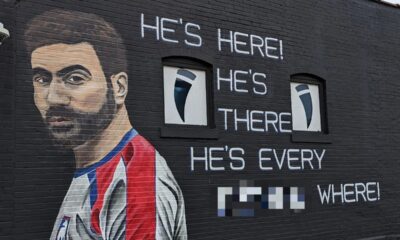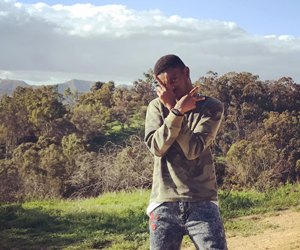Entertainment
A Newly Seinfeld-Approved Nikki Glaser Preps For Her Biggest Show Yet

click to enlarge BECKY DIGIGLIO Nikki Glaser’s standup sets are notorious for open-book descriptions of her life’s most intimate details.
St. Louis native Nikki Glaser is still buzzing from the night before. Not from booze — the 38-year-old comedian quit drinking 10 years ago. Not even from the previous night’s sold-out show in Atlantic City, part of Glaser’s The Good Girl Tour, which she describes as the best tour of her career. No, Glaser’s nerve endings are still smoldering because she just met Jerry Seinfeld for the first time. The two happened to be performing in separate showrooms at the same Atlantic City casino, after which the comedy legend summoned Glaser to his dressing room.
Gearing herself up to tell Seinfeld, one of her all-time heroes, how much he means to her, Glaser was flabbergasted when he gushed over her instead.
“It turns out he’s a huge fan!” she tells the RFT on a phone call from her New York City hotel room. “I was, like, ‘Are you doing an impression of the things that I was planning to say to you!?’ I was very shocked that he was even familiar with me, let alone a fan. It was awesome. It was one of the best moments of my career, and it just happened last night.”
Seinfeld’s praise was especially important to Glaser as someone who, despite considerable success and fame, still struggles with feelings of insecurity as a performer.
“I’m someone who always doubts myself a lot and always has imposter syndrome. I constantly question my talent,” she says. “But I’m not allowed to anymore because Jerry Seinfeld told me I was talented, and I really believe him, and he had evidence for it, and I will never forget the things that he said to me last night, and you can’t question Jerry Seinfeld.”
click to enlarge COURTESY PHOTO Even Jerry Seinfeld counts himself as a Nikki Glaser fan.
Such a bullet-train sentence of rapid-fire clauses is typical of Glaser, who continually demonstrates a head-spinning capacity for sizzling verbal runs that manage to be simultaneously funny, insightful and soul-baring. It’s this racing, high-voltage cognition that often has Glaser stuck in a continual cycle of fraught self-evaluation but which also makes her one of the funniest and most talented comics of her generation. Her last few years have seen a surge of successes: well-received Netflix and HBO standup specials, sold-out shows across the country, a highly popular podcast, a hosting role on HBO’s reality dating show Fboy Island, brutally hilarious celebrity-roast takedowns, a Carpool Karaoke episode with her favorite band Wilco, and on-air guest appearances that have made her a favorite of everyone from Howard Stern to Conan O’Brien.
Next on the list is an event Glaser expects to be another career pinnacle: her upcoming New Year’s Eve performance at Stifel Theatre, her biggest-ever headlining show.
“It’s a fucking honor!” she says. “I mean, I was happy with just the Pageant! That was the goal forever. So to be at this level — it’s above and beyond. I’m so excited to play that beautiful theater.”
Moreover, for the first time in many years, Glaser does not have to travel to play a homecoming show. After several years in New York and LA, Glaser moved back in with her parents in Kirkwood when COVID-19 wiped out live performances.
“I need to be around people, or I get lonely and depressed,” she says. “When the lockdowns happened I couldn’t do standup every night, and I needed people to be around, so I moved in with my parents.”
Glaser credits the slower pace of life back home with saving her from a work-induced breakdown.
“In the past eight or so years, as I’ve gotten more famous, more work has come in, and I can’t say no, so I was working all day and still doing standup at night,” she says. “So right before the pandemic, I was on the edge of serious burnout. I was kind of going insane.”
After a few months back in Kirkwood, Glaser grew reacquainted with a lifestyle that had comforts and benefits she had mostly forgotten. “I was, like, this is a sweet life! You just eat dinner and watch TV and go to bed,” she says. “I hadn’t had that life since high school.” As a result, Glaser stayed even after the lockdown was lifted, traveling out of town for gigs but making St. Louis her permanent home.
Asked about the attention she gets around town as a celebrity living in St. Louis, Glaser insists that she rarely gets recognized and is shocked whenever she does. She recently attended her high school reunion (Kirkwood High School, Class of 2002) and reports that her old classmates did not seem all that impressed with her, which she thinks is how it should be.
“The truth is — celebrity is dumb,” she says. “It’s an empty pursuit. It doesn’t actually bring you happiness. So I think St. Louis has it right.”
At the same time, Glaser remains full of internal contradictions, admitting that she herself is easily dazzled by famous people. She says, “I still get starstruck to this day. I mean, if I saw Becky, Queen of Carpet, I would freak out.”
After a year living in her childhood bedroom, Glaser moved to her current apartment in the Central West End, where she enjoys a routine of walking her dog, getting coffee, running in Forest Park, meditating, playing her guitar and recording The Nikki Glaser Podcast once a week. It’s a pace and state of normalcy that Glaser is reveling in.
“I watch the sunset or play Frisbee in the park with my boyfriend,” she says. “We go to yoga, and then we go out to dinner and then we watch White Lotus. It’s awesome.”
Her boyfriend is TV producer and radio personality Chris Convy, whom Glaser fans know from Welcome Home Nikki Glaser?, the reality show that chronicled her adventures in settling back in St. Louis. It’s the kind of candid look into Glaser’s life that has become her trademark. Her standup sets are notorious for open-book descriptions of her life’s most intimate details, which include raunchy, I-can’t-believe-she-said-that riffs on sex, masturbation, hygiene and other ribald topics.
“For whatever reason, I feel free to say whatever I want on stage, even more so than in a therapist’s office,” she says. “There is just something about an audience in the dark and having a microphone. I am more honest than I could ever be anywhere else.”
When asked about performing explicit material in front of her own parents, she says the shock for them wore off long ago.
“Oh my God, they have grown calluses over their ears at this point from all the things I’ve said,” she jokes. “They’re used to it. And my boyfriend’s dad has heard everything I could possibly say about what his son and I have allegedly done.”
And yet Glaser does admit to anxieties about playing St. Louis — particularly the possibility of running into someone afterward and sensing that they didn’t like the show, anxieties that she traces back to feelings she had 20 years ago in high school.
“My biggest fear is, like, some pretty girl from MICDS saying, ‘That was gross. You grossed us out,'” she says. “It’s like being in St. Louis makes me feel like I’m in high school again. Like, am I cool? Do people like me? I want to be accepted.”
Despite loving high school in general, Glaser recalls years of falling short of her desire to be exceptional. She tried swimming and field hockey (“I quit because I had bad shin splints. Also, I sucked,” she remembers), had no success with boys and failed to get leading roles in school plays.
“I would audition for The Diary of Anne Frank, and I would get Jewish Townsperson B,” she says. “I wanted the lead, and I wouldn’t even get close. It was pretty demoralizing.”
Then during her senior year, Glaser was cast in The Musical Comedy Murders of 1940 as Bernice, an uproarious, perpetually drunk character. “I just kind of played her as Karen on Will and Grace or as my mom on New Year’s Eve,” she laughs. Her drama teacher heaped praise on her performance, which she describes as a turning point — the first time she felt truly good at something.
Fast-forward to 2022, and the girl who was too scared to dance at Webster-Kirkwood Friendship Dances is about to pack the 3,100-seat Stifel Theatre for an adoring crowd on New Year’s Eve.
“It’s going to be a big night out!” she says. “There’s definitely going to be some pomp to it. It’s going to be more special than just a regular show. This is a dream gig, and I am going to be happier than I could ever be that night.”
And what if the old self doubts try to creep up?
“It’s different now,” she says. “Because I will have Jerry Seinfeld in my head saying, ‘You’ve got it, Nikki. You’ve got it.'”
Catch Nikki Glaser at 8 p.m. on Saturday, December 31, at the Stifel Theatre (1400 Market Street, 314-499-7600, stifeltheatre.com). Tickets are $36.75 to $76.75.
Coming soon: Riverfront Times Daily newsletter. We’ll send you a handful of interesting St. Louis stories every morning. Subscribe now to not miss a thing.Follow us: Google News | NewsBreak | Reddit | Instagram | Facebook | Twitter
Entertainment
Cicadas Are What’s for Dinner — But One Bug Lover Isn’t Happy

Last Friday, the Missouri Botanical Garden did something sure to shock the conscience of every good St. Louisan: They served up cicadas.The cicada scampi and spicy deep-fried cicada — yes, those were the actual dish names — were part of an cooking demonstration at MoBOT’s Sophia M. Sachs Butterfly House, a fun afternoon inspired by the cicadapocalypse now blanketing a big swath of St. Louis County with the long-gestating bugs.But not everyone found the idea so fun. In fact, one local put it upon themselves to try to stop the culinary demonstration. In a series of emails forwarded to the RFT by one of the many (many!) people CCed on them, this lone cicada warrior sought to make the case that eating bugs was beyond the pale — not because they’re gross, but because they can feel pain just like any living creature. “I’d do anything to stop this awful destruction of our nature,” wrote the anonymous advocate. “They aren’t bothering me or anyone bc I don’t bother them and nobody else will unless we have manager of Butterfly House insisting on a cruel needless heartless eating them event. Cicadas are chill they like trees [sic], they’re like frogs croaking you just live with it they’re talking mating that’s nature coexist [sic] and they just here for a minute.” The writer added, “The cicadas are not insignificant they have such amazing process of thoughts and feelings I have pulled out from dog water bowl couple times and you see their appreciation they have the most tight amazing little grip with their teeny claws like he held on and they look right at you. They are beautiful intricate.” We’re not sure we’d use “beautiful” to describe the little buggers, but de gustibus non est disputandum. And we’ll grant the cicada-loving activist this: They certainly do have short life spans.Asked about the potential controversy, MoBOT spokeswoman Catherine Martin told us on Friday they have not heard from others who feel the same way. She also notes that MoBOT took steps to shield the insect ingredients from pain: “Cicadas will be euthanized humanely before being cooked. The team will collect the cicadas and put them in a freezer. Since they are cold-blooded animals, the freezer temperature causes them to fall asleep and then pass away without pain. We never cook cicadas while they are still alive.” Would that lobsters could say the same! It’s worth noting that factory farming causes far more pain to animals that are far more sentient than cicadas (and, obviously, some people have made it their life’s work to try to stop those practices). Some animal lovers have suggested insects may be a better solution than, say, our current practices involving chickens. Notes Martin, “Eating insects is a common practice worldwide. The UN estimates that 2 billion people routinely eating insects, and humans consume more than 1,900 species of insects as food. Insects as human food provide protein, vitamins and minerals and are vastly more sustainable than other animal protein sources.” One last note while we consider the cicada: If you’re allergic to shellfish, you may well be allergic to these insects, too, since they are in fact closely related. Forget their “teeny claws” — that might be a great reason to proceed with caution towards that supper of cicada scampi.
Subscribe to Riverfront Times newsletters.Follow us: Apple News | Google News | NewsBreak | Reddit | Instagram | Facebook | Twitter | Or sign up for our RSS Feed
Entertainment
How Bob Cassilly Saved Michaelangelo’s Pietà

Bob Cassilly played a profound role in reshaping the look and feel of St. Louis. The sculptor turned curator and creator of City Museum, Turtle Park, and many other beloved local installations remains one of St. Louis’ most esteemed residents more than a decade after his tragic death in 2011.
But before Cassilly became a visionary for a new urban landscape, he played just as significant a role in preserving one of the world’s most beloved masterpieces, Michaelangelo’s sculpture Pietà. While the media covered the incident at the time, it’s become a forgotten chapter in Cassilly’s remarkable life.
Named with the Italian word for “pity,” the Pietà depicts Mary cradling the body of Jesus in the aftermath of the crucifixion. Erected by Michaelangelo in 1498 and 1499, it was installed at St. Peter’s Basilica in Vatican City in the 1600s and has spent most of its days there ever since, becoming one of the world’s most venerated works of art.
On May 21, 1972, Cassilly and his new bride were visiting St. Peter’s Basilica in Vatican City as part of their honeymoon, an old-fashioned grand tour of Europe, he told the St. Louis Post-Dispatch. As they approached Pieta, Cassilly saw a man with a long beard climb onto the sculpture. The man reportedly screamed about Jesus Christ and started desecrating the statue, smashing at Mary’s face and removing her hand with an implement that proved to be a geologist’s hammer, a fearsome tool with a long chisel head.
The man, Laszlo Toth, was a mentally ill Hungarian-born geologist who recently moved to Rome from Australia. According to reports by the Associated Press, Toth believed himself to be Jesus Christ and said that Mary was not his real mother.
click to enlarge Bystanders drag Laszlo Toth (right) away from the Pieta in St. Peters after he smashed it with a hammer. This photo was released by the Vatican the following day.
Cassilly was the first person to rush Toth and start to restrain him. He climbed the statue and grabbed at Toth’s beard. Cassilly punched Toth and brought his destruction to an end. “I leaped up and grabbed the guy by the beard,” Cassilly later told People Magazine. “We both fell into the crowd of screaming Italians. It was somewhat of a scene.” The young man from St. Louis’ courage inspired others to take down the hammer-wielding vandal.
Cassilly, Toth, and the others involved in the incident walked away with a few bruises, but the statue had suffered significant damage, both to Mary’s face and her left hand. Preservationists worked for years to restore Pietà to its original glory. The statue now sits in St. Peter’s Basilica behind bulletproof glass.
Toth was not charged with a crime but instead committed to a psychiatric hospital for two years. The Guardian reported that Toth later moved back to eastern Australia and lived in obscurity until his death in 2012.
Cassilly returned to St. Louis and opened a restaurant in Lafayette Park called Park Place, which he sold in 1978. Slowly but surely, he started earning commissions as a sculptor and began putting his own playful, historically-minded touches on the city’s landscape.
While Cassilly’s role in saving Pietà is surprisingly little known, it serves as an interesting and, in some ways, unsurprising footnote to his life’s work, which was seemingly forward looking and backward looking at the same time.
Subscribe to Riverfront Times newsletters.Follow us: Apple News | Google News | NewsBreak | Reddit | Instagram | Facebook | Twitter | Or sign up for our RSS Feed
Entertainment
The Best Things to Do in St. Louis This Weekend: May 16 to 19

Thursday 05/16
Skin Show In what has become a celebrated tradition for local lovers of boobs, butts and bawdy behavior (the four Bs!), the 13th Annual Show-Me Burlesque festival is bringing glitz, glam and a whole lot of ass to Cherokee Street this week. Though founder Lola van Ella no longer lives in St. Louis, she has made an indelible impression on the number of shaking ta-tas the city sees in any given year — and that’s a beautiful thing, in our book. This year’s three-day celebration will take place from Thursday, May 16 to Saturday, May 18 at the Golden Record (2720 Cherokee Street) and the nearby Casa Loma Ballroom (3354 Iowa Street). As is the case with these affairs, the festival promises “spectacular productions and fabulous burlesque, vaudeville, circus, and variety entertainment from every gender and from around the world,” according to promotional materials. The performers include the aforementioned van Ella, as well as Jeez Loueez, Auralie Wilde, Sailem and many more whose talents (among other things) will be on full display. The festivities kick off with an opening night bash at 7:30 p.m. on Thursday. Tickets range from $25 to $140 and can be purchased here at showmeburlesque.com/tickets.
Smooth Operation Those interested in the shinier things in life will find much to enjoy at the Saint Louis Art Museum’s (1 Fine Arts Drive) Shimmering Silks: Traditional Japanese Textiles, 18th-19th Centuries exhibit. Curated by Philip Hu, SLAM’s curator of Asian art, the exhibit features more than a dozen works that came to the museum as gifts or purchases over the last century, and celebrates traditional silk textiles from the 1700s through the 1800s. During that time period, SLAM says, “the main centers of traditional silk textiles in Japan were the old imperial capitals of Nara and Kyoto, supplying a clientele that included the imperial family, members of the hereditary nobility, feudal lords and ladies, high-ranking Buddhist clergy and the uppermost echelons of civil society.” The most lavish silks were used for imperial and Buddhist ceremonies, performances of Kabuki and Noh theater, formal wear and wedding costumes — so we’re talking about some high-quality stuff here. The exhibit will be on view during SLAM’s normal business hours through October 20, and admission is free. Details at slam.org.
Friday 05/17
Forget All Your Cares Outside of sporting events, there can be a dearth of large-scale gatherings in downtown St. Louis these days— let’s face it, many of the city’s biggest celebrations take place where the tallest buildings aren’t. But this week breaks that trend, as the City Social Block Party returns for its third year, throwing one of the biggest, best block parties in town in the heart of the city on Washington Avenue. The event will feature live music, food, drinks and games. It’s like the neighborhood party you might have on your street — except the damn whole town is invited. Wash Ave eateries such as Hot Pizza Cold Beer, Levels, Sugarfire and many others will be hosting pop-ups on the sidewalk, keeping everyone fed, while 4 Hands Brewery will be among the great vendors serving drinks. Tons of phenomenal music acts will take the stage at Washington and 14th Street, including Marquise Knox, DJ Mahf, Joanna Serenko and more. Best of all, the whole affair is completely free to attend. The good times start at 5 p.m. For more information, visit shorturl.at/vEKSU.
A Matter of Taste Get ready to celebrate everything that is great about the Maplewood and Richmond Heights food scenes this weekend at the 16th Annual Taste of Maplewood Street Festival. Held on Friday, May 17 from 6 to 10 p.m. and Saturday, May 18 from noon to 8 p.m., this big block party aims to bring neighbors together while also supplying a small sample of all the area has to offer. In addition to downing tasty bites from local restaurants, guests can stop by the tents at this free festival and do a little shopping. There will also be two stages set up with plenty of entertainment options — enjoy performances from Mattie Schell, the Chris Shepherd Band, Raised on Radio and more, or catch the St. Louis Irish Arts song and dance exhibition on Saturday afternoon. Visit midcountychamber.org for more information, including the entertainment schedule, details on where to park and a list of vendors scheduled to be on site.
Saturday 05/18
Outside(r) Art Bougie types may hold out for Clayton’s Saint Louis Art Fair, where artists have to apply and it’s hard to find a painting for less than $800. But if your tastes run to quirky, not fancy, you will find yourself happily at home at the Bevo BAZAAR-O, the wonderfully named yard sale/craft fair in Bevo Mill. Unlike some of the more uptight affairs in this town, there’s no screening of these vendors — they just pay $10 per parking spot at 5000 Gravois Avenue, set up a display of their crap and get to selling. Sure, that lack of overall quality control means you’re assuredly going to find some real junk — but also, who knows what kind of treasures lurk in south city? The event runs from 9 a.m. to 3 p.m. on Saturday, May 18. Attendance is free. Details at shorturl.at/jBT67.
Sunday 05/19
One Last Hurrah Lo-Fi Cherokee said its goodbyes last month, as the low-key festival featuring a series of single-day music video shoots spent one last Saturday capturing a dozen local musical acts in and around Cherokee Street businesses. But because this is a music video festival, not a music festival, the fun isn’t really over until the videos premiere — and that makes this Sunday, May 19, the true end of the festival that videographer Bill Streeter started 14 years ago. Sob! Swing by Off Broadway (3509 Lemp Avenue) for the Lo-Fi Cherokee Final Premiere Party to see the results of Streeter’s day-long sprint and celebrate the community that’s sprung up around it. Oh, and you can catch some pretty good music videos, too. Doors open at 7 p.m. with the screening at 8 p.m. Tickets are $10. Details at lofistl.com.
Subscribe to Riverfront Times newsletters.
Follow us: Apple News | Google News | NewsBreak | Reddit | Instagram | Facebook | Twitter | Or sign up for our RSS Feed
-

 Entertainment1 year ago
Entertainment1 year agoSt.Louis Man Sounds Just Like Whitley Hewsten, Plans on Performing At The Shayfitz Arena.
-

 Business1 year ago
Business1 year agoWe Live Here Auténtico! | The Hispanic Chamber | Community and Connection Central
-
Board Bills1 year ago
2022-2023 Board Bill 189 — Public Works and Improvement Program at the Airport
-

 Local News1 year ago
Local News1 year agoVIDEO: St. Louis Visitor Has Meltdown on TikTok Over Gunshots
-

 News1 year ago
News1 year agoTed Lasso-inspired pop-up bar now open in St. Louis
-

 Board Bills1 year ago
Board Bills1 year ago2022-2023 Board Bill 165 — Jefferson Arms Community Improvement District
-
Board Bills1 year ago
2022-2023 Board Bill 183 — Amending Ordinance Number 62885 known as the Capital Improvements Sales Tax
-

 News10 months ago
News10 months agoGas tanker crashes into St. Louis Metro transit center





